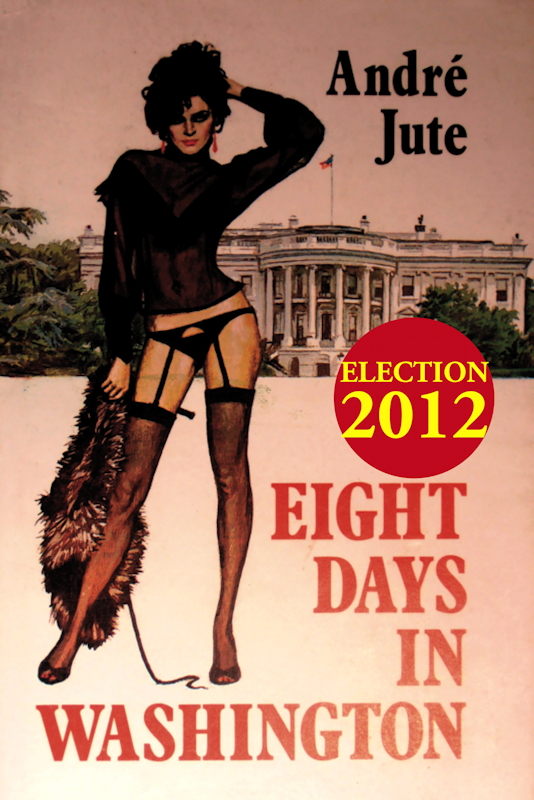Sample Chapter from
STIEG LARSSON Man, Myth & Mistress
by André Jute & Andrew McCoy
Is Lisbeth Salander a feminist?
Larsson’s strongest character, Salander, is the worst example of his inability to keep his characters in control, and the most blatant failure caused by the superimposed feminist theme. The Salander character is a riotous success in spite of Larsson trying to claim her for feminism, not because of it.
Larsson tells us again and again that the key to the story is his feminist anguish over violence against women. He tells us often both didactically, in his flat authorial voice, and in action that Salander is the protector or at least the righteous avenger of abused women, a David-sized female goel hadam, the Biblical avenger of wrongs done to those who cannot strike back. But Salander, in the tidy archive of someone who did her no harm,
left the newsletters in piles all over the desk — something for that slut Lindgren to take care of tomorrow.
Some feminist! No wonder Larsson, despite Gabrielsson’s best efforts to beatify him, has posthumous trouble with the feminists. And this is quite apart from the fact that Salander looks and acts more like a slut than the minor character Lindgren who is merely uptight and disapproving; even in this quick sketch Lindgren is clearly a paragon of net-curtain-twitching Swedish small-town rectitude. And it is all so needless. If Larsson had done the author’s job of revision, if the editors had been allowed to edit rather than to cringe in fear of Gabrielsson’s foolish disapproval, this crap would have been gone in the first pass. It’s essentially mickey mouse stuff, tiny irritating splinters on a planed piece of wood before sanding. But no craftsman would send out the plank without running sandpaper over it. Larsson did, making one wonder if he was really as working-class as the mythologizers claim.
By way of comparison, consider a better class of interior tension, where Larsson reaches as high up the literary scale as he is capable of — or perhaps as he intends to. Those who’ve read The Girl with the Dragon Tattoo should have the background information to look for four entirely different kinds of tension in this brief paragraph:
Dammit, he had treated her like a human being. She got out of bed and stood by the window, restlessly peering into the dark. The hardest thing for her was to show herself naked to another person for the first time. She was convinced that her skinny body was repulsive. Her breasts were pathetic. She had no hips to speak of. She did not have much to offer.
First, we’ve already been told by Dragan Armansky that he (risibly) saw Salander as ‘the perfect victim’, and we’ve certainly seen her abused. Psychologists who work with abused women know that one of the hazards of such work is that they feel they have to reward the smallest kindness with all that they have, sex. There is a body posture associated with this, technically called ‘presenting’. That is the image ‘Dammit, he had treated her like a human being’ calls up entirely falsely, possibly even deliberately falsely. It fits with what we know so far of Salander’s treatment, but in fact it doesn’t fit with what we’ll discover later about her abuse.
Next Salander gets out of bed and stands naked by the window for twenty minutes, indecisive. Totally out of character but quite credibly so. The tension mounts.
But the rest of her musings, the bodily self-loathing, are not feminist thoughts; feminists are not supposed to obsess about physical appearance! But then who said Salander is a feminist? She avenges the underdogs, and some of them happen to be female, but that’s not to be a feminist, that’s just fairness. In fact, the only feminist in Salander’s life is the philanderer Mikael Blomkvist.
By the beginning of the second book, The Girl Who Played with Fire, Salander, even as an exceedingly doubtful feminist, has gone entirely off the rails:
When she came back into the room she stood naked in front of the mirror on the wardrobe door and examined her body with amazement. She still weighed less than ninety pounds and stood four foot eleven. Well, there was not much she could do about that. She had doll-like, almost delicate limbs, small hands, and hardly any hips.
But now she had breasts.
All her life she had been flat-chested, as if she had never reached puberty. She thought it had looked ridiculous, and she was always uncomfortable showing herself naked.
Now, all of a sudden, she had breasts. They were by no means gigantic—that was not what she had wanted, and they would have looked ridiculous on her otherwise skinny body—but they were two solid, round breasts of medium size. The enlargement had been well done, and the proportions were reasonable. But the difference was dramatic, both for her looks and for her self-confidence.
Now Larsson is really having it every which way, a short-ass, no-ass anorexic heroine for men who like boys, with big tits on a waif’s body for those who like young girls. How the hell could Eva Gabrielsson, who ten years later claims these were conceived as ‘feminist’ novels, have let Larsson commit these atrocities? That ‘But now she had breasts’ stands in a paragraph by itself tells us what importance author and character put on appearances, on appeal to men. And a couple of lines further on, again, ‘Now, all of a sudden, she had breasts.’ This verges on pornography.
Perhaps in Sweden that sort of prurient near-smut goes down well, or at least unremarked. The most likely truth is ironic: a British editor didn’t cut one or both those lines, or at least fold the first one back into a less thrusting display (pun intended) because the author was dead, there was no one to approve the cut, and Gabrielsson, the only other credible person to ask, behaved as if every Larsson doodle was Holy Scripture, fixed beyond the providence of mere editors. If so, the law of unintended effect here struck a mighty blow against her pretense that Larsson was a feminist.
Salander would have to be stupid not to work out that there must be plenty of feminists in the child protection agencies and other social services. Yet far from protecting her, they were in the vanguard of her persecution. Why should she trust them now? Larsson here missed an opportunity to make more of his belief that the social services in Sweden are gears in the machine of fascist oppression.
We are never shown that Salander is a joiner; in fact, her participation with a group of friends in a bar is stiff and awkward compared to her unstressed camaraderie with the antisocial, even smelly hackers; one is left with the impression about the drinking group that either Salander is making an effort because she has been told that it is normal to belong (out of character for her to comply), or that Larsson’s control over his character has slipped again and that she’s acting out his fantasy of sociability. By contrast, her relationships with Blomkvist and with Mimmi, her lesbian lover, and even the loyalty she inspires in Armansky, show Salander as more capable of one-to-one relationships than integrating into a group. In any event, it is impossible to believe that Salander would stay long in a feminist, or any other, group before she lost patience with them, or they with her.
Salander is hugely intelligent and, despite the piercings and the tattoos, is no supine fashion victim; the fashionable self-mutilation is not a psychological by-product of her abuse but deliberate camouflage and a reminder to take revenge. Salander tells the tattooist of her ankle band as much, in one of the best exchanges of dialogue in the entire trilogy:
She chose a simple little tattoo depicting a narrow band and asked to have it put on her ankle. She pointed.
‘The skin is very thin there. It’s going to hurt a lot,’ said the tattoo artist.
‘That’s OK,’ Salander said, taking off her jeans and putting her leg up.
‘OK, a band. You already have loads of tattoos. Are you sure you want another one?’
‘It’s a reminder.’
Feminism, like other forms of special pleading, generally presumes that adherents also agree to a panoply of leftwing ‘causes’, some of them extremely silly. Can you really see Salander accept someone else’s agenda unexamined? If Salander is indeed a feminist, she is more likely to belong to the Germaine Greer wing, who’re sexual liberationists first and feminists second and distantly. Indeed, Salander in her refusal to interact with her bureaucratic and psychological persecutors is the perfect practitioner of Greer’s incisive observation:
Loneliness is never more cruel than when it is felt in close propinquity with someone who has ceased to communicate.
Even tied to a bed Salander makes her tormentors feel unwanted failures, so could someone please explain to a poor confused critic why Salander, as an adult, needs either feminist theory or feminists themselves. What can feminists do for Salander? In the light of their failure to protect her before, why should Salander want them?
Most telling of all, there is no reason for Salander to be a feminist. Whatever it may have been conceived as, the finished Millennium Trilogy is in essence the story of a woman beating every thug that society could send against her, and triumphing over every disability it imposed on her for despicable reasons. By the end of the first volume of the trilogy, The Girl with the Dragon Tattoo, Salander has surged through the glass ceiling. If Salander were a feminist, the other two volumes would be no more than cleaning up. The only reason those two thick books make sense is because in our hearts we know Salander is not a feminist.
To summarize, there is no need for Salander to be a feminist, it would be uncharacteristic of her to join the feminists (or any other organized group), it is very likely impossible for her to be accepted as a feminist, even if she were accepted she would be out after scoffing at the associated agenda… The list just goes on and on.
***
On the other hand — no such thing as literary criticism without caveats! — we can easily see Salander’s actions as the wish-fulfillment of many feminists. But then her actions are wish-fulfillment for everyone, men and non-feminist women as well; even a Nobel Laureate dreams of setting up crooked financiers for assassination by the Mafia by hacking into their tax haven accounts to transfer their ill-gotten gains to his own bank. Mario Vargas Llosa calls Blomkvist and Salander vigilantes, and excuses the bad literature of their convoluted adventures in the light of their righteous cause — which he carefully does not spell out as feminism, quite as carefully as he overlooks Salander hanging on to Wennerström’s millions. We might call Vargas Llosa’s politics as exposed here selective feminism and selective socialism, which at least sounds more important than plain old hypocrisy.
In short, Salander as a feminist is plain bullshit — and we cannot be certain it is all Larsson’s bullshit rather than Gabrielsson’s. She described herself and Larsson as, ‘two stubborn people’ and goes on to paint a shiver-making personal and literary consequence: ‘So when Lisbeth is against an idea, when she goes completely silent… that's exactly like me. That's where he got it from.’
As a comic book avenger, Salander is superb, as a feminist her foam falsies get her stopped at the barrier of credibility.







